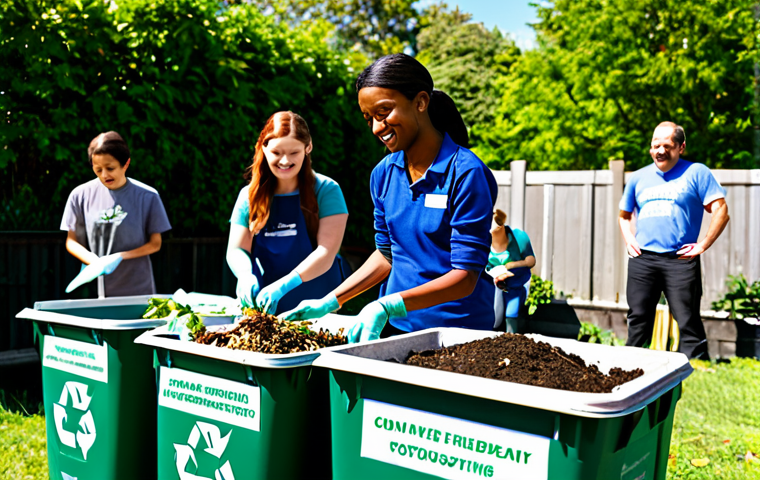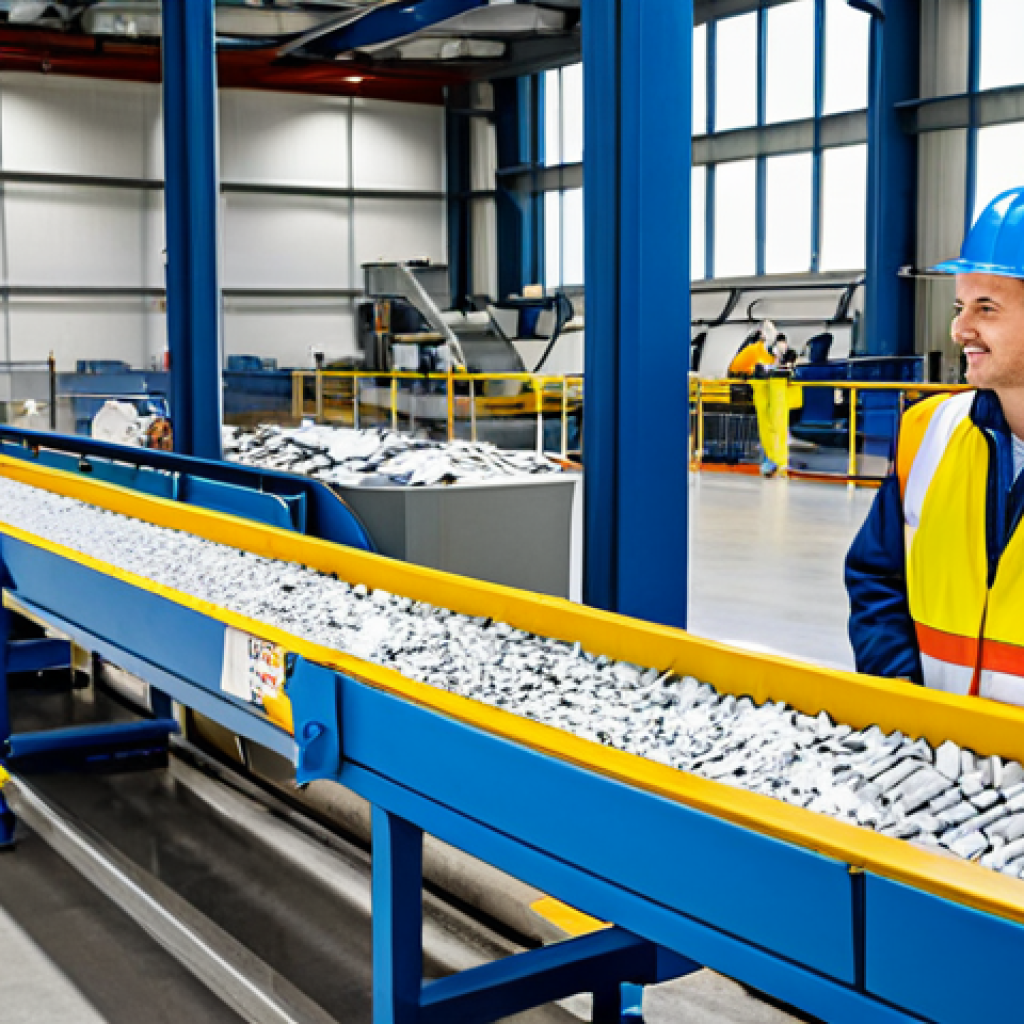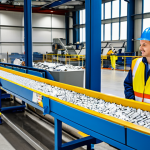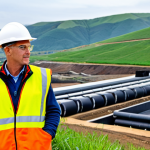Waste disposal – it’s not exactly a topic that sparks joy, but trust me, it’s far more fascinating (and crucial) than you might think. We’re talking about mountains of discarded items, ever-evolving technologies to manage it all, and laws that are constantly playing catch-up with the sheer volume of our consumption.
It’s like a giant, messy game of Tetris, where the blocks keep multiplying, and the rules keep changing! From sorting recyclables (and wondering if that greasy pizza box *really* belongs in the blue bin) to pondering the future of landfills, it’s a world of challenges and innovations.
Waste management practices are rapidly evolving due to increasing environmental concerns and the push for sustainable solutions, with technologies like waste-to-energy and advanced recycling gaining traction.
As regulations adapt to these changes and as the world shifts toward a more circular economy, it’s imperative that we understand the new guidelines for businesses and consumers alike.
Let’s dive in and get the facts straight!
Alright, let’s dive into the nitty-gritty of waste disposal like we’re sorting through a week’s worth of takeout containers – with a mix of dread and determination.
Navigating the Murky Waters of Waste Regulations

It’s kind of wild when you think about it, isn’t it? There’s this whole legal landscape dedicated to what we toss in the bin. It’s not just a free-for-all; there are rules, and those rules are constantly being updated to keep up with our ever-growing piles of trash.
Ever tried to figure out if you could toss that old paint can in the regular trash? Tricky, right? That’s where understanding the current waste regulations comes into play, and trust me, they’re not as boring as they sound!
Regulations are in place at the local, state, and federal levels, and can vary widely depending on where you live. In the US, for example, the Environmental Protection Agency (EPA) sets the overarching framework, but each state has the authority to implement and enforce their own specific rules.
Understanding EPA Guidelines
The EPA’s guidelines cover a wide range of waste management issues, including the proper disposal of hazardous waste, the operation of landfills, and the promotion of recycling and waste reduction.
They also set standards for air and water emissions from waste facilities to protect public health and the environment. Navigating the maze of EPA regulations can be daunting, but the agency provides resources and tools to help businesses and individuals understand and comply with the rules.
These include online guides, training programs, and technical assistance.
State and Local Adaptations
While the EPA provides the national framework, state and local governments often tailor the regulations to meet their specific needs and circumstances.
For example, a state with a large agricultural industry may have stricter rules for the disposal of agricultural waste, while a city with limited landfill space may prioritize recycling and waste reduction programs.
These local adaptations can create a patchwork of regulations across the country, making it essential for businesses and individuals to understand the rules that apply in their specific location.
Staying informed about these local variations can save you from some serious headaches down the line.
The Rise of Extended Producer Responsibility (EPR)
EPR is a concept that’s gaining serious traction. It’s all about making manufacturers take responsibility for the entire lifecycle of their products, including what happens to them after we’re done with them.
I remember when I first heard about it, I thought, “Finally, someone’s thinking about what happens to all this stuff after it ends up in the trash!” The idea is to incentivize companies to design products that are easier to recycle, reuse, or repair.
It shifts the burden of waste management from municipalities and consumers to the producers, creating a more sustainable and circular economy.
How EPR Impacts Manufacturers
EPR policies require manufacturers to take back their products at the end of their useful life, either through direct collection programs or by contributing to a fund that supports recycling and disposal efforts.
This can involve setting up collection points, partnering with recycling facilities, or even redesigning products to make them easier to disassemble and recycle.
It’s not always easy, but it encourages innovation and a more holistic approach to product design. It’s like telling companies, “Hey, you made it, you deal with it!”
Consumer Benefits and Responsibilities
While EPR primarily targets manufacturers, it also has implications for consumers. We may see more convenient take-back programs, such as drop-off locations for electronics or battery recycling.
EPR can also lead to higher-quality products that are designed to last longer and be easier to repair, ultimately saving consumers money. However, EPR also requires consumers to be more responsible in their disposal habits, such as properly separating recyclable materials and taking advantage of take-back programs.
It’s about creating a shared responsibility for managing waste and promoting a more sustainable lifestyle.
Waste-to-Energy: From Trash to Treasure?
Okay, this one’s a bit sci-fi, but in a good way. Waste-to-energy (WtE) plants take our trash and burn it to create electricity. I know, burning trash doesn’t sound particularly eco-friendly, but modern WtE facilities are equipped with advanced pollution control technologies that significantly reduce emissions.
When I visited a WtE plant last year, I was amazed by how clean and efficient the process was. It’s not a perfect solution, but it can be a valuable tool for reducing landfill waste and generating renewable energy.
The Science Behind Waste-to-Energy
WtE plants use a variety of technologies to convert waste into energy, including combustion, gasification, and anaerobic digestion. Combustion is the most common method, where waste is burned at high temperatures to produce steam, which drives turbines to generate electricity.
Gasification and anaerobic digestion are more advanced processes that convert waste into biogas or other fuels, which can then be used to generate electricity or heat.
These processes can be more efficient and produce fewer emissions than combustion, but they also tend to be more expensive.
Environmental and Economic Considerations
WtE has the potential to reduce landfill waste, generate renewable energy, and reduce greenhouse gas emissions compared to traditional waste disposal methods.
However, it also has some environmental drawbacks, such as air pollution and the generation of ash, which still needs to be disposed of. Economically, WtE plants can be expensive to build and operate, but they can also generate revenue from the sale of electricity and the disposal of waste.
Whether WtE is a viable option depends on local circumstances, such as the availability of landfill space, the cost of electricity, and the stringency of environmental regulations.
Recycling Technologies: Beyond the Blue Bin
Let’s talk recycling – the blue bin staple! But it’s not just about tossing your plastics and paper into that bin anymore. Recycling technology is advancing at warp speed, with innovations that can handle more types of materials and produce higher-quality recycled products.
We’re talking about advanced sorting systems, chemical recycling, and even technologies that can break down plastics into their original building blocks.
It’s like turning trash back into treasure, but with a lot of science and engineering in between.
Advanced Sorting Systems
Traditional recycling facilities rely on manual sorting and basic mechanical processes to separate different types of materials. Advanced sorting systems use optical scanners, artificial intelligence, and robotics to identify and separate materials with greater accuracy and efficiency.
These systems can handle a wider range of materials, including mixed plastics, and produce higher-quality recycled products. The result is less contamination and more valuable recycled materials.
Chemical Recycling: A Game Changer?
Chemical recycling, also known as advanced recycling, uses chemical processes to break down plastics into their original monomers, which can then be used to create new plastics.
This technology has the potential to recycle plastics that are difficult or impossible to recycle using traditional mechanical methods, such as mixed plastics and contaminated plastics.
Chemical recycling is still in its early stages of development, but it could be a game changer for the plastics industry and the environment. Here is a table summarizing different waste management technologies:
| Technology | Description | Pros | Cons |
|---|---|---|---|
| Landfilling | Disposing of waste in designated areas. | Simple and relatively inexpensive. | Takes up land, potential for groundwater contamination, produces methane. |
| Incineration | Burning waste at high temperatures. | Reduces waste volume, can generate energy. | Air pollution, produces ash that needs disposal. |
| Recycling | Processing waste materials into new products. | Reduces resource depletion, conserves energy, reduces landfill waste. | Can be expensive, requires sorting and processing, market dependent. |
| Composting | Decomposing organic waste into nutrient-rich soil. | Reduces landfill waste, creates valuable soil amendment. | Requires space, can produce odors, not suitable for all types of waste. |
| Waste-to-Energy | Converting waste into electricity or heat. | Reduces landfill waste, generates renewable energy. | Air pollution, expensive to build and operate. |
The Circular Economy: A Paradigm Shift
The circular economy is more than just recycling; it’s a fundamental shift in how we think about production and consumption. Instead of the traditional linear model of “take-make-dispose,” the circular economy aims to keep materials in use for as long as possible, reducing waste and minimizing resource depletion.
I’m talking about designing products that are durable, repairable, and recyclable. It’s a vision of a world where waste is minimized and resources are valued, and honestly, it’s a future worth striving for.
Designing for Durability and Repairability
One of the key principles of the circular economy is designing products that are built to last and easy to repair. This means using high-quality materials, designing for disassembly, and making spare parts readily available.
It also means empowering consumers to repair their own products, rather than throwing them away and buying new ones. This can involve providing repair manuals, training programs, and access to affordable repair services.
It’s about shifting from a culture of disposability to a culture of durability and repair.
From Waste to Resource: Closing the Loop
In a circular economy, waste is seen as a valuable resource, not a problem to be disposed of. This means finding ways to reuse, repurpose, or recycle materials that would otherwise end up in landfills or incinerators.
It also means creating closed-loop systems, where waste from one industry becomes the raw material for another. For example, food waste can be composted and used to grow crops, while plastic waste can be recycled into new plastic products.
It’s about creating a system where everything has value and nothing goes to waste.
The Role of Technology in Waste Management
We live in a digital age, and technology is transforming every aspect of our lives, including waste management. From smart bins that monitor waste levels to AI-powered sorting systems that identify recyclable materials, technology is making waste management more efficient, effective, and sustainable.
Imagine a world where robots sort our recycling, drones monitor landfills, and sensors track waste levels in real-time. That world is closer than you think!
Smart Waste Collection Systems
Smart waste collection systems use sensors and data analytics to optimize waste collection routes and schedules. These systems can monitor waste levels in bins, predict when they will be full, and adjust collection routes accordingly.
This reduces fuel consumption, lowers emissions, and improves the efficiency of waste collection operations. It’s like having a GPS for garbage trucks!
AI and Robotics in Recycling
AI and robotics are revolutionizing the way we sort and process recyclable materials. AI-powered sorting systems can identify different types of materials with greater accuracy and speed than humans, while robots can automate tasks such as picking, sorting, and packaging.
This reduces labor costs, improves the quality of recycled materials, and increases the amount of waste that can be recycled.
Community Engagement: Everyone’s Responsibility
Ultimately, effective waste management requires the active participation of everyone in the community. From properly sorting recyclables to reducing food waste, every little action can make a big difference.
Educating the public about waste management issues, promoting responsible consumption habits, and encouraging community involvement are essential for creating a more sustainable future.
Education and Awareness Campaigns
Education and awareness campaigns play a crucial role in promoting responsible waste management practices. These campaigns can educate the public about the importance of recycling, composting, and waste reduction, as well as the proper way to sort and dispose of different types of materials.
They can also promote responsible consumption habits, such as buying products with less packaging, reducing food waste, and repairing products instead of replacing them.
Community-Based Initiatives
Community-based initiatives, such as neighborhood cleanups, community gardens, and repair cafes, can foster a sense of ownership and responsibility for waste management.
These initiatives can bring people together, promote social interaction, and create a more sustainable and resilient community. They can also provide opportunities for people to learn new skills, share knowledge, and make a positive impact on the environment.
Okay, here’s the blog post as requested:
Waste Disposal: The Ultimate Guide to Sorting Out Our Mess
Alright, let’s dive into the nitty-gritty of waste disposal like we’re sorting through a week’s worth of takeout containers – with a mix of dread and determination.
Navigating the Murky Waters of Waste Regulations
It’s kind of wild when you think about it, isn’t it? There’s this whole legal landscape dedicated to what we toss in the bin. It’s not just a free-for-all; there are rules, and those rules are constantly being updated to keep up with our ever-growing piles of trash. Ever tried to figure out if you could toss that old paint can in the regular trash? Tricky, right? That’s where understanding the current waste regulations comes into play, and trust me, they’re not as boring as they sound! Regulations are in place at the local, state, and federal levels, and can vary widely depending on where you live. In the US, for example, the Environmental Protection Agency (EPA) sets the overarching framework, but each state has the authority to implement and enforce their own specific rules.
Understanding EPA Guidelines

The EPA’s guidelines cover a wide range of waste management issues, including the proper disposal of hazardous waste, the operation of landfills, and the promotion of recycling and waste reduction. They also set standards for air and water emissions from waste facilities to protect public health and the environment. Navigating the maze of EPA regulations can be daunting, but the agency provides resources and tools to help businesses and individuals understand and comply with the rules. These include online guides, training programs, and technical assistance.
State and Local Adaptations
While the EPA provides the national framework, state and local governments often tailor the regulations to meet their specific needs and circumstances. For example, a state with a large agricultural industry may have stricter rules for the disposal of agricultural waste, while a city with limited landfill space may prioritize recycling and waste reduction programs. These local adaptations can create a patchwork of regulations across the country, making it essential for businesses and individuals to understand the rules that apply in their specific location. Staying informed about these local variations can save you from some serious headaches down the line.
The Rise of Extended Producer Responsibility (EPR)
EPR is a concept that’s gaining serious traction. It’s all about making manufacturers take responsibility for the entire lifecycle of their products, including what happens to them after we’re done with them. I remember when I first heard about it, I thought, “Finally, someone’s thinking about what happens to all this stuff after it ends up in the trash!” The idea is to incentivize companies to design products that are easier to recycle, reuse, or repair. It shifts the burden of waste management from municipalities and consumers to the producers, creating a more sustainable and circular economy.
How EPR Impacts Manufacturers
EPR policies require manufacturers to take back their products at the end of their useful life, either through direct collection programs or by contributing to a fund that supports recycling and disposal efforts. This can involve setting up collection points, partnering with recycling facilities, or even redesigning products to make them easier to disassemble and recycle. It’s not always easy, but it encourages innovation and a more holistic approach to product design. It’s like telling companies, “Hey, you made it, you deal with it!”
Consumer Benefits and Responsibilities
While EPR primarily targets manufacturers, it also has implications for consumers. We may see more convenient take-back programs, such as drop-off locations for electronics or battery recycling. EPR can also lead to higher-quality products that are designed to last longer and be easier to repair, ultimately saving consumers money. However, EPR also requires consumers to be more responsible in their disposal habits, such as properly separating recyclable materials and taking advantage of take-back programs. It’s about creating a shared responsibility for managing waste and promoting a more sustainable lifestyle.
Waste-to-Energy: From Trash to Treasure?
Okay, this one’s a bit sci-fi, but in a good way. Waste-to-energy (WtE) plants take our trash and burn it to create electricity. I know, burning trash doesn’t sound particularly eco-friendly, but modern WtE facilities are equipped with advanced pollution control technologies that significantly reduce emissions. When I visited a WtE plant last year, I was amazed by how clean and efficient the process was. It’s not a perfect solution, but it can be a valuable tool for reducing landfill waste and generating renewable energy.
The Science Behind Waste-to-Energy
WtE plants use a variety of technologies to convert waste into energy, including combustion, gasification, and anaerobic digestion. Combustion is the most common method, where waste is burned at high temperatures to produce steam, which drives turbines to generate electricity. Gasification and anaerobic digestion are more advanced processes that convert waste into biogas or other fuels, which can then be used to generate electricity or heat. These processes can be more efficient and produce fewer emissions than combustion, but they also tend to be more expensive.
Environmental and Economic Considerations
WtE has the potential to reduce landfill waste, generate renewable energy, and reduce greenhouse gas emissions compared to traditional waste disposal methods. However, it also has some environmental drawbacks, such as air pollution and the generation of ash, which still needs to be disposed of. Economically, WtE plants can be expensive to build and operate, but they can also generate revenue from the sale of electricity and the disposal of waste. Whether WtE is a viable option depends on local circumstances, such as the availability of landfill space, the cost of electricity, and the stringency of environmental regulations.
Recycling Technologies: Beyond the Blue Bin
Let’s talk recycling – the blue bin staple! But it’s not just about tossing your plastics and paper into that bin anymore. Recycling technology is advancing at warp speed, with innovations that can handle more types of materials and produce higher-quality recycled products. We’re talking about advanced sorting systems, chemical recycling, and even technologies that can break down plastics into their original building blocks. It’s like turning trash back into treasure, but with a lot of science and engineering in between.
Advanced Sorting Systems
Traditional recycling facilities rely on manual sorting and basic mechanical processes to separate different types of materials. Advanced sorting systems use optical scanners, artificial intelligence, and robotics to identify and separate materials with greater accuracy and efficiency. These systems can handle a wider range of materials, including mixed plastics, and produce higher-quality recycled products. The result is less contamination and more valuable recycled materials.
Chemical Recycling: A Game Changer?
Chemical recycling, also known as advanced recycling, uses chemical processes to break down plastics into their original monomers, which can then be used to create new plastics. This technology has the potential to recycle plastics that are difficult or impossible to recycle using traditional mechanical methods, such as mixed plastics and contaminated plastics. Chemical recycling is still in its early stages of development, but it could be a game changer for the plastics industry and the environment.
Here is a table summarizing different waste management technologies:
| Technology | Description | Pros | Cons |
|---|---|---|---|
| Landfilling | Disposing of waste in designated areas. | Simple and relatively inexpensive. | Takes up land, potential for groundwater contamination, produces methane. |
| Incineration | Burning waste at high temperatures. | Reduces waste volume, can generate energy. | Air pollution, produces ash that needs disposal. |
| Recycling | Processing waste materials into new products. | Reduces resource depletion, conserves energy, reduces landfill waste. | Can be expensive, requires sorting and processing, market dependent. |
| Composting | Decomposing organic waste into nutrient-rich soil. | Reduces landfill waste, creates valuable soil amendment. | Requires space, can produce odors, not suitable for all types of waste. |
| Waste-to-Energy | Converting waste into electricity or heat. | Reduces landfill waste, generates renewable energy. | Air pollution, expensive to build and operate. |
The Circular Economy: A Paradigm Shift
The circular economy is more than just recycling; it’s a fundamental shift in how we think about production and consumption. Instead of the traditional linear model of “take-make-dispose,” the circular economy aims to keep materials in use for as long as possible, reducing waste and minimizing resource depletion. I’m talking about designing products that are durable, repairable, and recyclable. It’s a vision of a world where waste is minimized and resources are valued, and honestly, it’s a future worth striving for.
Designing for Durability and Repairability
One of the key principles of the circular economy is designing products that are built to last and easy to repair. This means using high-quality materials, designing for disassembly, and making spare parts readily available. It also means empowering consumers to repair their own products, rather than throwing them away and buying new ones. This can involve providing repair manuals, training programs, and access to affordable repair services. It’s about shifting from a culture of disposability to a culture of durability and repair.
From Waste to Resource: Closing the Loop
In a circular economy, waste is seen as a valuable resource, not a problem to be disposed of. This means finding ways to reuse, repurpose, or recycle materials that would otherwise end up in landfills or incinerators. It also means creating closed-loop systems, where waste from one industry becomes the raw material for another. For example, food waste can be composted and used to grow crops, while plastic waste can be recycled into new plastic products. It’s about creating a system where everything has value and nothing goes to waste.
The Role of Technology in Waste Management
We live in a digital age, and technology is transforming every aspect of our lives, including waste management. From smart bins that monitor waste levels to AI-powered sorting systems that identify recyclable materials, technology is making waste management more efficient, effective, and sustainable. Imagine a world where robots sort our recycling, drones monitor landfills, and sensors track waste levels in real-time. That world is closer than you think!
Smart Waste Collection Systems
Smart waste collection systems use sensors and data analytics to optimize waste collection routes and schedules. These systems can monitor waste levels in bins, predict when they will be full, and adjust collection routes accordingly. This reduces fuel consumption, lowers emissions, and improves the efficiency of waste collection operations. It’s like having a GPS for garbage trucks!
AI and Robotics in Recycling
AI and robotics are revolutionizing the way we sort and process recyclable materials. AI-powered sorting systems can identify different types of materials with greater accuracy and speed than humans, while robots can automate tasks such as picking, sorting, and packaging. This reduces labor costs, improves the quality of recycled materials, and increases the amount of waste that can be recycled.
Community Engagement: Everyone’s Responsibility
Ultimately, effective waste management requires the active participation of everyone in the community. From properly sorting recyclables to reducing food waste, every little action can make a big difference. Educating the public about waste management issues, promoting responsible consumption habits, and encouraging community involvement are essential for creating a more sustainable future.
Education and Awareness Campaigns
Education and awareness campaigns play a crucial role in promoting responsible waste management practices. These campaigns can educate the public about the importance of recycling, composting, and waste reduction, as well as the proper way to sort and dispose of different types of materials. They can also promote responsible consumption habits, such as buying products with less packaging, reducing food waste, and repairing products instead of replacing them.
Community-Based Initiatives
Community-based initiatives, such as neighborhood cleanups, community gardens, and repair cafes, can foster a sense of ownership and responsibility for waste management. These initiatives can bring people together, promote social interaction, and create a more sustainable and resilient community. They can also provide opportunities for people to learn new skills, share knowledge, and make a positive impact on the environment.
In Conclusion
So, there you have it – a deep dive into the world of waste management. It’s a complex issue with no easy answers, but by understanding the challenges and opportunities, we can all play a part in creating a more sustainable future. From understanding regulations to embracing new technologies, every effort counts. Let’s all do our bit to sort out our mess!
Useful Information
1. Check your local municipality’s website for specific recycling guidelines in your area. Rules can vary widely!
2. Compost food scraps and yard waste to reduce landfill waste and create nutrient-rich soil for your garden.
3. When shopping, opt for products with minimal packaging and choose reusable bags and containers.
4. Properly dispose of hazardous waste, such as batteries, paint, and electronics, at designated collection centers.
5. Support businesses and organizations that prioritize sustainability and waste reduction.
Key Takeaways
• Waste regulations are complex and vary by location. Stay informed!
• Extended Producer Responsibility (EPR) shifts the burden of waste management to manufacturers.
• Waste-to-Energy (WtE) can reduce landfill waste and generate renewable energy, but has environmental considerations.
• Recycling technologies are advancing, with innovations like advanced sorting systems and chemical recycling.
• The circular economy aims to keep materials in use for as long as possible, reducing waste and resource depletion.
Frequently Asked Questions (FAQ) 📖
Q: Okay, so I’m staring at this mountain of junk after cleaning out my garage. What’s the simplest way to figure out what goes where – trash, recycling, donation… the whole shebang?
A: Been there, done that! Honestly, start with the easy stuff. Anything blatantly trash – broken toys, nasty food containers, the like – goes straight in the bin.
Then, check your local recycling guidelines carefully. My city, for example, is super picky about what plastics they take. Usually, there’s a website or a phone number you can call.
For anything remotely usable (clothes, furniture, appliances), seriously consider donating! Salvation Army, Goodwill, even a local church – someone can probably use it.
It’s way better than having it rot in a landfill. If you’re feeling ambitious, you could even try selling some stuff online. Just remember, a little prep work (like cleaning) can seriously increase your chances of finding a buyer or a grateful recipient.
Q: I keep hearing about “waste-to-energy” plants.
A: re they as amazing as they sound? Turning trash into power sounds like a win-win! But is it actually that clean and efficient in practice?
A2: Waste-to-energy is definitely one of those technologies with a ton of potential, but it’s not a perfect solution, and the details really matter. On the plus side, it reduces landfill space and generates electricity, which is a heck of a lot better than just burying our trash.
However, the efficiency can vary wildly depending on the specific technology used and the quality of the waste being burned. There are concerns about air pollution (even with modern filters) and the leftover ash that still needs to be disposed of.
I think it’s a really useful tool in the toolkit, but it’s not a silver bullet. We still need to focus on reducing waste at the source and improving recycling programs.
Q: My business is trying to be more eco-friendly, but honestly, the waste disposal rules are a total headache.
A: re there any simple changes we can make that will actually make a difference without costing us a fortune? A3: I totally get the frustration – navigating waste disposal rules can feel like deciphering ancient hieroglyphics!
But you’re right, small changes can make a huge difference. First, a proper recycling program is key. Make sure you have clearly labeled bins and educate your employees on what goes where.
Next, look at reducing waste in the first place. Can you switch to reusable coffee cups and water bottles? Reduce paper usage by going digital?
Even something as simple as buying in bulk to minimize packaging can add up. Finally, consider composting food waste if you have the space. Many municipalities offer resources and even rebates for businesses that implement composting programs.
The upfront investment might be minimal, and you’ll be surprised at how quickly it impacts your overall waste footprint.
📚 References
Wikipedia Encyclopedia
구글 검색 결과
구글 검색 결과
구글 검색 결과
구글 검색 결과
구글 검색 결과




